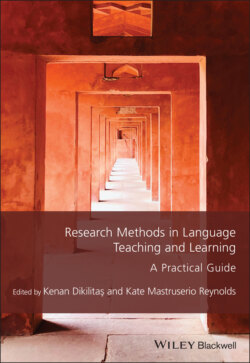Читать книгу Research Methods in Language Teaching and Learning - Группа авторов - Страница 18
Moving Towards a Qualitative Case Study Approach
ОглавлениеI am unsure whether, prior to 2003, I had read much qualitative case study research related to language teacher development. However, by November that year, Borg’s (2001) grammar teacher cognition case studies were clearly having an impact on my thinking, since, in Progress Report 5, I was speculating on the prior development and self-efficacy beliefs of two of Borg’s cases, therefore engaging in “naturalistic generalization” (Lincoln & Guba, 1985) prompted by the “thick description” (Geertz, 1973) in Borg’s writing.
Subsequently, while I reviewed the literature, my appreciation grew of the need for qualitative case study research into teachers’ self-efficacy (TSE) beliefs that is “teachers’ beliefs in their capabilities of supporting learning in various task- and context-specific cognitive, metacognitive, affective and social ways” (Wyatt, 2008, p. 5). My understanding of TSE beliefs had been shaped by my reading of Bandura’s (1986) theory and by my earlier experiences of researching language learners’ self-efficacy beliefs (Wyatt, 2000). However, on fully engaging with the TSE beliefs literature in 2004, I found much confusion. Though based on “a simple idea with significant implications” (Tschannen-Moran & Woolfolk Hoy, 2001, p. 783), numerous studies appeared to be conceptually problematic, with the construct frequently misunderstood and misapplied, as had already been recognized (Henson, 2002; Wheatley, 2002), and has been discussed more fully since (Klassen et al., 2011; Wheatley, 2005; Wyatt, 2014). Klassen et al. (2011, p. 37) complain, for example, of definitional entropy, whereby “carefully defined psychological constructs lose precision over time”; besides sharing this concern, I was troubled by the very global (i.e., insufficiently task-specific) way in which TSE beliefs were generally assessed in many quantitative studies, and by erroneous assumptions that TSE beliefs were relatively inflexible and therefore not open to change (Wyatt, 2008, 2014).
Qualitative case studies researching TSE beliefs were clearly in short supply. Only 2 of the 218 studies published between 1998 and 2009 that were reviewed by Klassen et al. (2011) were in this category, this despite various researchers (e.g., Labone, 2004; Tschannen-Moran et al., 1998; Wheatley, 2005) explicitly calling for the use of interpretive qualitative case study research methodology to develop in-depth understandings.
Given the scarcity of qualitative case studies of TSE beliefs, and the benefits I had derived from reading Borg’s (2001) grammar teacher cognition cases, I read the two qualitative TSE beliefs case studies I had identified with interest. Indeed, in my literature review (Wyatt, 2008), I then presented vignettes extracted from both Milner and Woolfolk Hoy (2003) and Mulholland and Wallace (2001) to demonstrate, in a field dominated by quantitative research methodology, the potential for learning about TSE beliefs from qualitative case study research.
Strengths of one of these cases (Milner & Woolfolk Hoy, 2003) includes its use of “triangulation” (Stake, 1995), with several forms of this drawn upon. Evident was: “data source triangulation,” which involves considering the consistency of the phenomenon observed over time; “methodological triangulation,” where different methods are combined; and “member checks,” whereby data are discussed with research participants. However, a weakness of the study was that “theory triangulation,” whereby alternative theoretical explanations are considered, seemed absent; this appeared problematic since the construct of self-efficacy beliefs was unfortunately misconstrued in this study (in terms of “lofty goals,” rather than specific tasks).
I also detected flaws in Mulholland and Wallace’s (2001) account of a beginning teacher’s struggle to use group work in a “hands-on” way in elementary science lessons in Australia. Concentrating on exploring the teacher’s development through “a psychological lens” (Tschannen-Moran et al., 1998, p. 203) in a way consistent with TSE beliefs theory (Bandura, 1986), the researchers nevertheless did so somewhat narrowly; I felt that analytical perspectives from the fields of teacher cognition and teacher education were lacking. Wheatley (2005, p. 760) argues for “a merging of fields” in research into TSE beliefs, drawing together expertise from different specialist areas. Reading Mulholland and Wallace’s (2001) story, I found myself wondering about the role of practical knowledge in the teacher’s development; how had this grown in relation to her developing TSE beliefs? I was also curious about the role of mentoring that encouraged deep reflection, and indeed about the role of reflection itself, a term which appeared only early in the article. Space was doubtless limited in Mulholland and Wallace’s (2001) conclusions and implications section, but I felt that a more holistic interpretation of the complexities of the multiple realities under investigation, which can be one of the strengths of case study (Stake, 1995), would have been welcome.
